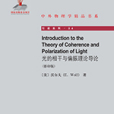《光的相干與偏振理論導論(英文影印版)》是2014年9月19日出版的圖書,作者是沃爾夫。
基本介紹
- 中文名:光的相干與偏振理論導論(英文影印版)
- 作者:沃爾夫
- 出版時間:2014年09月19日
- 出版社: 北京大學出版社
- 頁數:240 頁
- ISBN:9787301245484
- 定價:41 元
- 開本:16 開
- 裝幀:平裝
- 叢書名:中外物理學精品書系
出版背景,精彩片段,章節目錄,
出版背景
所有的光場都是隨機漲落的,有些光場的隨機漲落很小,例如許多雷射器輸出的光;有些光場的隨機漲落相當大,例如從熱光源輻射的光。描述漲落光場的基礎理論是相干理論。部分偏振現象就是漲落的重要表現。實際上,相干理論所能處理的問題不僅限於漲落。與常規的處理方法不同,相干理論是依據可觀測量描述光場,並解釋這些可觀測量,例如光的光譜以及它在傳輸中如何變化的。 本書給出了光的相干與偏振現象的統一處理方法。適合光通信、雷射光束在光纖中和通過湍流大氣傳輸、光學成像,尤其在顯微鏡成像(例如醫學診斷)的物理界和工程界的研究者閱讀。
精彩片段
光的相干和偏振是光學中最重要的現象,其套用也極為廣泛。本書作者是國際光學界的著名學者,在相關的研究取中取得過突破性的進展。也正是因為作者的貢獻,本書能夠以統一處理方法研究光的相干與偏振這兩種現象。對於光通信、光學成像等領域的研究者及研究生,乃至對此領域感興趣的讀者來說,本書是不可多得的優秀讀物。
章節目錄
Preface page xi
1. Elementary coherence phenomena 1
1.1 Interference and statistical similarity 1
1.2 Temporal coherence and the coherence time 4
1.3 Spatial coherence and the coherence area 5
1.4 The coherence volume 8 Problems 10
2. Mathematical preliminaries 11
2.1 Elementary concepts of the theory of random processes 11
2.2 Ergodicity 17
2.3 Complex representation of a real signal and the envelope of a narrow-band signal 19
2.4 The autocorrelation and the cross-correlation functions 22
2.5 The spectral density and the Wiener-Khintchine theorem 25
Problems 29
3. Second-order coherence phenomena in the space-time domain 31
3.1 Interference law for stationary optical fields. The mutual coherence function and the complex degree of coherence 31
3.2 Generation of spatial coherence from an incoherent source. The van Cittert-Zernike theorem 37
3.3 Illustrative examples 46
3.4 Propagation of the mutual intensity 54
3.5 Wave equations for the propagation of mutual coherence in free space 56 Problems 58
4. Second-order coherence phenomena in the space-frequency domain 60
4.1 Coherent-mode representation and the cross-spectral density as a correlation function 60
4.2 The spectral interference law and the spectral degree of coherence 63
4.3 An illustrative example: spectral changes on interference 69
4.4 Interference of narrow-band light 73 Problems 76
5. Radiation from sources of different states of coherence 79
5.1 Fields generated by sources with different coherence properties 79
5.2 Correlations and the spectral density in the far field 81
5.3 Radiation from some model sources 88
5.4 Sources of different states of spatial coherence which generate identical distributions of the radiant intensity 95
5.5 Coherence properties of Lambertian sources 97
5.6 Spectral changes on propagation. The scaling law 102 Problems 108
6. Coherence effects in scattering 111
6.1 Scattering of a monochromatic plane wave on a deterministic medium 111
6.2 Scattering of partially coherent waves on a deterministic medium 115
6.3 Scattering on random media 118
7. Higher-order coherence effects 129
7.1 Introduction 129
7.2 Intensity interferometry with radio waves 131
7.3 The Hanbury Brown-Twiss effect and intensity interferometry with light 134
7.4 Einstein's formula for energy fluctuations in blackbody radiation and the wave-particle duality 140
7.5 Mandel's theory of photoelectric detection of light fluctuations 143
7.6 Determination of statistical properties of light from photocount measurements 149
8. Elementary theory of polarization of stochastic electromagnetic beams 154
8.1 The 2 _ 2 equal-time correlation matrix of a quasi-monochromatic electromagnetic beam 154
8.2 Polarized, unpolarized and partially polarized light. The degree of polarization 158
9. Unified theory of polarization and coherence 174
9.1 The 2 _ 2 cross-spectral density matrix of a stochastic electromagnetic beam 174
9.2 The spectral interference law, the spectral degree of coherence and the spectral degree of polarization of stochastic electromagnetic beams 175
9.3 Determination of the cross-spectral density matrix from experiments 179
9.4 Changes in random electromagnetic beams on propagation 181
9.5 Generalized Stokes parameters 194
Appendices 202
(I) Cells of phase space and the degeneracy parameter 202
(a) Cells of phase space of a quasi-monochromatic light wave (Section 1.4) 202
(b) Cells of phase space of radiation in a cavity (Sections 7.4 and 7.5) 204
(c) The degeneracy parameter 206 II Derivation of Mandel's formula for photocount statistics [Eq.(2) of Section 7.5.1] 208 III The degree of polarization of an electromagnetic Gaussian Schell-model source 210 IV Some important probability distributions 212
(a) The binomial (or Bernoulli) distribution and some of its limiting cases 212
(b) The Bose-Einstein distribution 214
Author index 216
Subject index 220

